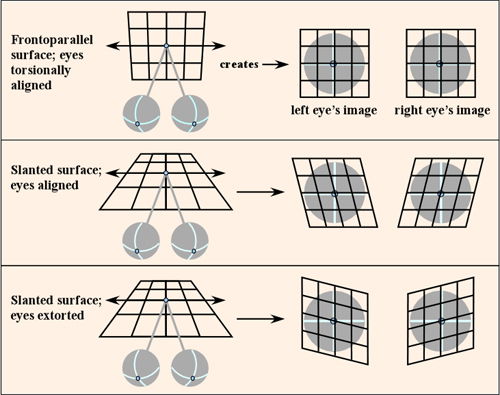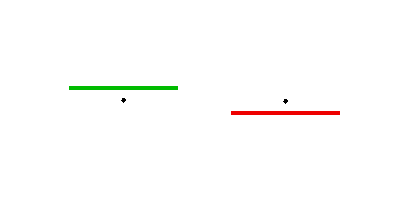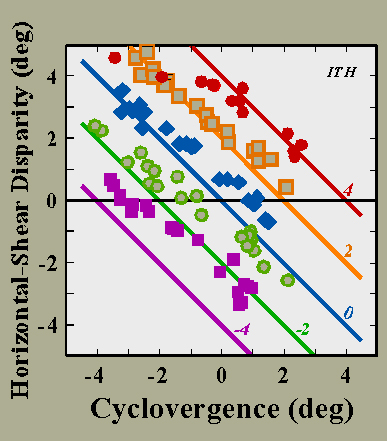
background
When a plane is rotated about a horizontal axis, the horizontal disparities created by the plane change in a predictable fashion. The sketch below illustrates the linkage between slant about a horizontal axis and horizontal shear disparity. A top view of the viewing situation is on the left and a side view in the upper right. You can vary the distance to the simulated plane by dragging the dot labeled "Fixation Point" in the top view. You can vary the slant by dragging the dot labeled "Vary Slant" in the side view. A stereogram is presented in the lower right. To view it properly, position yourself ~30 cm in front of the screen, forehead parallel to the screen. Cross your eyes such that the left eye is directed toward the dot in the middle of the right figure and the right eye toward the dot in the left figure. (This is cross-fusing.) You should see three dots and sets of concentric squares; we're interested in the middle one. As you alter the surface slant by dragging the appropriate dot, notice the change in perceived slant in the stereogram. Changes in slant about a horizontal axis create a vertical gradient of horizontal disparity, which is typically called horizontal shear disparity.
Estimating Slant when the Surface is Rotated about a Horizontal Axis
The horizontal disparities created by rotating a surface about a horizontal axis are horizontal-shear disparities. As the surface is rotated such that the top becomes farther away, the left eye's image of a vertical on the surface rotates counter-clockwise and the right eye's image clockwise. The angle between these two projections is the horizontal-shear disparity (H). If the eyes are torsionally aligned (meaning that the eyes' horizontal meridians are co-planar), the slant of the surface is given to very close approximation by:

where "mu" is the vergence of the eyes (angle between the lines of sight). The eyes, however, are not torsionally aligned in all viewing situations. Specifically, the eyes make torsional movements (rotations about the line of sight). Cyclovergence refers to rotations in opposite directions in the two eyes.

|
The diagram on the left illustrates how cyclovergence alters the horizontal-shear disparity at the retinas (H). In the upper panel, the eyes are torsionally aligned and are fixating a frontal plane (slant = 0); H = 0. In the middle panel, the eyes are again torsionally aligned, but the plane is now slanted; H > 0. In either panel, the surface slant could be recovered by using the equation above. In the lower panel, the plane is slanted by the same amount as in the middle panels, but the eyes are extorted (right eye clockwise, left eye counter-clockwise). H = 0 because the disparity created by the plane's slant is offset by the disparity created by the cyclovergence. If the visual system did not compensate for the disparity change caused by the eyes' cyclovergence, the slant estimate would be erroneous. Said another way, the above equation will not return the correct slant in this situation.
Torsional Eye Movements
Here we demonstrate how changes in the position of an object relative to the head can cause the eyes to rotate about the lines of sight. Position yourself less than 30 cm in front of the screen, forehead parallel to the screen. Cross your eyes such that the left eye is directed toward the dot above the red line and the right eye toward the dot below the green line. (This is cross-fusing.) You should see three dots and we're interested in the middle one and particularly the green and red lines above and below it. Notice that the green and red lines are roughly parallel. Now slowly rotate the head downward (keeping distance and up-down position constant), so that you have to turn the eyes upward to cross-fuse the dots. As you rotate downward, you'll notice that the red and green lines no longer appear parallel; the red line appears rotated clockwise relative to the left. This occurs because with downward head rotation, the eyes make torsional eye movements (rotate about the lines of sight), but those movements aren't large enough to keep the two eyes aligned. Now rotate the head upward and notice that the opposite occurs. As we said in the previous page, these torsional eye movements create disparities between the two eyes' images and, unless the brain has some way to compensate for those changes, errors in slant perception would occur.

We have shown that cyclovergence causes a change in horizontal-shear disparity and that if the visual system did not compensate for the eye torsion, slant would be misperceived. How might the system compensate for eye torsion?
It could in principle compensate by using an eye-muscle signal as an estimate of the cyclovergence:

where "mu" is the eyes' horizontal vergence (the angle between the lines of sight) and "tau-hat" is the estimate of the eyes' cyclovergence according to an eye-muscle signal.
The visual system could also compensate in principle by using the vertical disparities that arise when the eyes make a cyclovergence eye movement. Specifically, when the eyes are not torsionally aligned, vertical-shear disparity (V) arises along the horizontal meridians of the eyes and this can be used as a measure of the cyclovergence. You can see the vertical disparity due to cyclovergence in the lower panel of the previous page.

We conducted a series of experiments to determine whether the visual system compensates for the effects of cyclovergence and, if it does, whether it uses an eye-muscle signal, vertical disparities, or both to do so.
We asked human observers to adjust the slant of a stereoscopically defined surface (a plane of bright dots on an otherwise dark background) until it appeared to have a slant of 0 (perpendicular to the line of sight). We induced cyclovergence by having the observers first fixate a pattern that was rotated about its center in one direction in the left eye and in the other direction in the right eye. We also introduced vertical-shear disparity into the test stimulus (the plane of dots) so we could see if the visual system uses the vertical disparities to compensate.

|
The results are shown in the figure on the top. The horizontal-shear disparity (at the retinas) that yielded a perceived slant of 0 is plotted as a function of the cyclovergence of the eyes. The five sets of lines and data points (red, orange, blue, green, and purple) correspond to the different vertical-shear disparities that were added to the test stimulus. The predictions of the three possible means of compensation are represented by the lines. If no compensation occurred, the data would all lie on the black horizontal line. If compensation based on a veridical, eye-muscle signal occurred, the data would all fall on the blue diagonal line. If compensation based on vertical disparity occurred, the data would fall on the five colored lines (each set of data points falling on the line of the same color). Clearly the data are most consistent with compensation via vertical disparity.
and the visual system doesn't use an extra-retinal signal to compensate for torsion
Having shown that the visual system uses vertical-shear disparity to compensate for cyclovergence, we next investigated whether an extra-retinal signal is also used (but perhaps with lower weight). We conducted the same experiment, but with a much smaller stimulus (5 deg in diameter as opposed to 35 deg). With such a small stimulus, the vertical disparities are very small and difficult to measure. We hoped that we would see evidence for use of an eye-muscle signal when vertical-shear disparity was made difficult to measure.
|
The figure on the top shows the data from this experiment. Again the horizontal-shear disparity (at the retinas) is plotted as a function of the eyes' cyclovergence. The symbols of different colors again correspond to different vertical-shear disparities added to the stimulus. If no compensation for cyclovergence occurred, the data would fall on the black horizontal line. If compensation via vertical disparity occurred, the data would fall on the five diagonal lines (the data of a given color falling on the line of the same color). If compensation via an eye-muscle signal occured, the data would fall on the blue diagonal line. The data are most consistent with no compensation. This suggests that when vertical disparities are made difficult to measure, the visual system simply fails to compensate for cyclovergence. A simple prediction from this is the following. If the stimulus is a smooth vertical line and the top and bottom of the line are invisible, it should appear to change slant as the eyes make cyclovergence movements. We have tested this and the change in perceivd slant in fact occurs.


![]()


![]()
![]()
